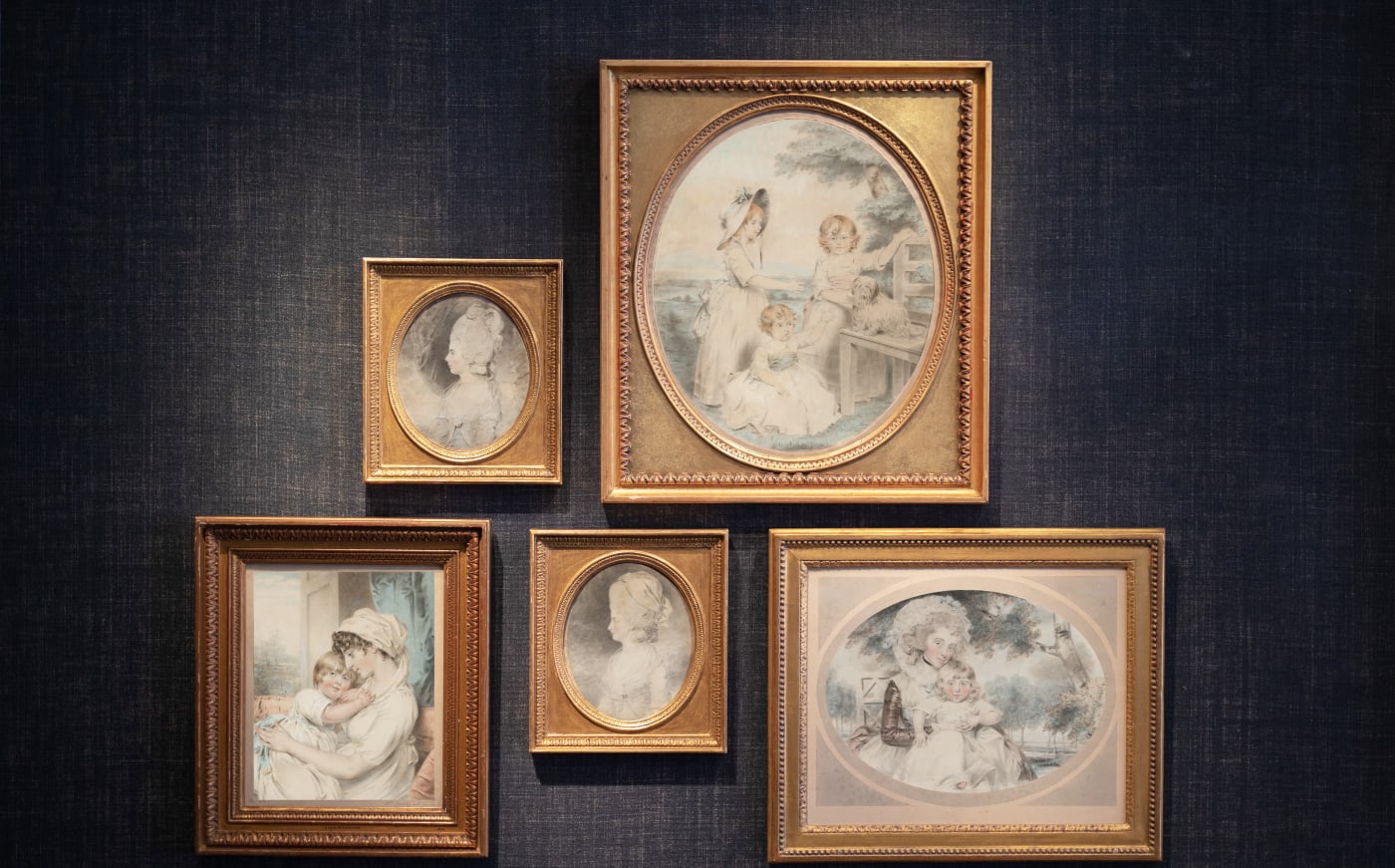As an artist, Downman was most successful when he limited himself to portraiture. The aristocratic and fashionable flocked to his studio almost as soon as he began his independent career.
Downman In Vogue Born in North Wales, John Downman (1750-1824) was expected to follow his father in his profession as a local attorney. From the time he could pick up a pencil it was clear that he was a talented artist and, in his teens, he began training in Liverpool. In 1769, he entered the newly formed Royal Academy Schools where he was taught by Benjamin West. West remained something of a hero for Downman throughout his life. West supported his former pupil’s burgeoning professional career but was also representative of an artist who seamlessly moved between grand ‘history’ painting and portraiture (which largely paid the bills). Downman described West as his ‘most beloved teacher’[1] , and in 1777 painted a portrait of him in oils on copper in which West holds the preliminary drawing for the finished oil. Downman’s artistic training continued, as with so many artists of the eighteenth century, in Italy, where he travelled with Joseph Wright...
Downman In Vogue
Born in North Wales, John Downman (1750-1824) was expected to follow his father in his profession as a local attorney. From the time he could pick up a pencil it was clear that he was a talented artist and, in his teens, he began training in Liverpool. In 1769, he entered the newly formed Royal Academy Schools where he was taught by Benjamin West. West remained something of a hero for Downman throughout his life. West supported his former pupil’s burgeoning professional career but was also representative of an artist who seamlessly moved between grand ‘history’ painting and portraiture (which largely paid the bills). Downman described West as his ‘most beloved teacher’[1], and in 1777 painted a portrait of him in oils on copper in which West holds the preliminary drawing for the finished oil.
Downman’s artistic training continued, as with so many artists of the eighteenth century, in Italy, where he travelled with Joseph Wright of Derby. On his return to England he established himself as a portrait painter in Cambridge in 1776 and by 1778 he was working in London and the West Country, which he visited frequently over the following thirty years.
As an artist, Downman was most successful when he limited himself to portraiture. The aristocratic and fashionable flocked to his studio almost as soon as he began his independent career. This is supported by drawings of the Waldegrave sisters, Charlotte Maria and Anna Horatia, both portraits dated 1780. This was the same year that the sisters, along with their third sibling Laura, were painted by Sir Joshua Reynolds in one of his most ambitious oil paintings. Unmarried, the sisters were to be separated as over the next six years they moved to their marital residences. The grandnieces of Horace Walpole. the girls’ mother had secretly remarried the Duke of Gloucester, brother of George III. Although the family were therefore intimately connected to the Royal family, they were not received at court due to the enduring anger of the king, who had not approved the match. A commission from such prominent (and slightly scandalous) members of the aristocracy so early in his career drove others swiftly to Downman’s studio door. Soon, the most renowned member of London’s elite, fashion-conscious society, Georgiana, Duchess of Devonshire and the queen of tragic actresses, Sarah Siddons, had both commissioned portraits from the young artist.
Downman’s ability to capture a likeness using his unique blend of black chalk and stump over graphite, with highlights of watercolour on both sides of his favoured wove paper allowed for a swift sitting. While oil portraits could take days, even weeks, to complete, Downman’s portraits required the sitter’s prescence for just a few hours. Using chalk, he could also take an impression of each portrait and over time built up albums of his portraits, which he called ‘first studies’.[2] If a sitter wished to commission more than one version, Downman used these ‘first studies’ to provide them with any number they wished to buy. For more complex compositions, like the portrait group of the daughters of the 7th Earl Cavan, Downman would take quick sketches which could then be arranged into a landscape or interior setting. In many ways, he worked like a modern fashion photographer, capturing a snapshot of a moment in time.
To his enduring disappointment, Downman never followed West in becoming a member of the Royal Academy, only achieving ‘associate’ status. Furthermore, his attempt at ‘high’ art, such as history painting, was not well received by critics. Through his portraits, however, Downman captured a moment in time which managed to be transient and permanent in equal measure. The relaxed nature of his portraits and fast method used to capture his sitters allowed a glimpse into the private world of the rich and famous. Fleeting fashions, young babies and favoured pets were often excluded from oil paintings, which were intended to stand the test of time. Downman revelled in such details, hoping that such highly personalised images would ‘diffuse Friendship and renew Affection, even after Death; for what is represented faithfully not only delights but is ever a soothing memoir, that revives the dearest Feelings’.[3]
[1] Dr Williamson, John Downman, A.R.A. His Life and Works, (London, 1907), p. xii; D. Foskett, Miniatures Dictionary and Guide, (Woodbridge, 1987), p.530.
[2] These ‘first studies’ are now preserved in albums in the British Museum (London) and Fitzwilliam Museum (Cambridge).
[3] J. Munro, John Downman 1750-1824, Fitzwilliam Museum, Cambridge, 1996, p. 11









